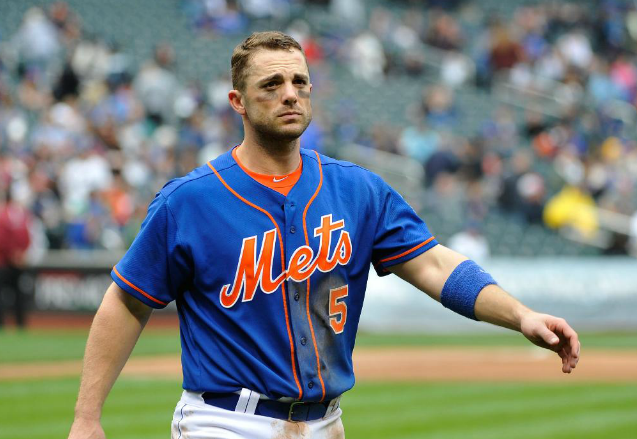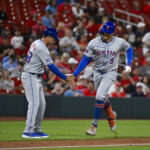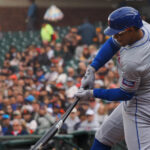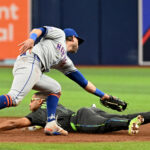
Six weeks into a season that stretches over six months may be a tad early to make pronouncements on expected outcomes for this year’s Mets squad, but the indicators of relative strengths and weaknesses have at least given a reasonable hint of what can be looked for going forward. A sub-.500 record with a propensity for generosity by the bullpen and parsimony on the part of the offense hasn’t inspired a great deal of optimism in fans at this point. Not that there were many of us ready to try to make a convincing case for a division crown going into this season, but as always we remain hopeful and ready to be pleasantly surprised. The unexpected run toward respectability that occurred during the first part of the 2012 campaign might yet re-surface this year as a second half surge, something that would actually be a more hopeful sign of things to come. As we await the inevitable arrival of Zack Wheeler, Travis D’Arnaud, et al later this summer, it seems worthwhile to evaluate yet again how the overall roster might best be shaped.
The twin issues of a porous bullpen and an impotent lineup seem to be continual matters of concern. Of course, were the rotation more consistent at providing quality outings, the bullpen wouldn’t be as overtaxed as it seems to be and perhaps more able to provide adequate support. On the other hand, a bounty of run production would compensate greatly for less than shutdown outings from the relief corps, but lacking even middle-of-the-pack scoring ability since an uncharacteristic eruption to begin the season, we are left to look for the domination of a Harvey start and cross our fingers in-between.
So, unwilling to write the season off entirely at this point, what strategy best serves management’s multiple goals of major league player development, minor league nurturing, and fielding a product respectable enough to generate sufficient revenue from an increasingly impatient fan base? Do they continue along the current path, waiting for the team as presently comprised to round into shape and begin playing close to what more bullish expectations had envisioned? If so, where does one finally draw the line if that level of performance isn’t forthcoming before a certain time period has elapsed (let’s say, hmmmm…, the All-Star Break)? Or, if more drastic action is deemed appropriate, who is most directly affected by that action?
So many questions, but not that many readily apparent answers. As the roster is made up largely of relative youngsters with potential and varying track records of success (Ike, Murphy, Tejada, Duda, Niese, Parnell, Gee, Harvey, Valdespin, Turner, Lagares, Carson, Familia), with an added sprinkling of seasoned veterans (Wright, Buck, Hawkins, Atchison, Byrd, Marcum, Lyon), and role players (Baxter, Brown, Rice, Recker, Hefner), the Mets are in a position that seemingly requires that we all bite the bullet and wait out the unavoidable growing pains of a franchise in the middle stages of a rebuild. Sandy Alderson’s statements in regard to the possible fate of Terry Collins indicate that his expectations are more closely focused on development of young talent than on the team’s won/lost record this year, although one would expect an improvement in the latter as an outgrowth of the former. From an historic viewpoint then, could we conceive of the 2013 season as being analogous to 1983 as a harbinger of good things to come? One of the keys to the transition of that team from bottom dweller to contender and eventual champion was not only the establishment of later rotation stalwarts Ron Darling and Walt Terrell, but the mid-season acquisition of Keith Hernandez as a consistent veteran presence in the lineup and in the clubhouse. These moves were instrumental in the remarkable year-over-year gain of 22 wins for the 1984 squad, though adding in a couple of pitchers by the names of Gooden and Fernandez didn’t hurt, either.
If there is to be a similar advancement over the next season or so for the Citi-dwellers of 2013, we will need to see results with the ostensible rotation strategy in the form of the debut and successful development of at least two starters from the vaunted arsenal of Met hurlers-to-be. Zack Wheeler’s debut now seems fairly imminent, but it would be a stretch to expect the likes of a Montero or Syndergaard much in advance of late 2014. In the meantime, I would expect more in the form of placeholders like Collin McHugh until the more dominant arms are ready. Ultimately, to make the move from mediocrity to the upper echelon of the league will require contributions from the starting staff in the form of multiple 200+ inning seasons from the majority of the rotation. Such was the case in ’84 when Messrs. Gooden, Darling, and Terrell all achieved the feat. As to the questions of if and when the Mets could expect to receive production of that magnitude from the current crop of arms making their way to Flushing, your guess is as good as mine.
It is worth noting that the 1984 squad received significant production from its outfield corps, getting 60 HR’s and 75 SB’s from the starting trio of Foster, Wilson and Strawberry, and topped that off with solid contributions from Hernandez and Hubie Brooks at the infield corners. The deficiencies of the current Mets outfield have been covered ad nauseum at this point so I won’t rehash them, but suffice it to say that an acquisition or two would appear to be absolutely vital going forward for the balance of the strategy to be effective. The timing of this aspect of roster construction can be highly variable and opportunistic. The key move for the 1983 team was clearly the Hernandez trade, something that came about largely as a result of a personality clash between Keith and Cardinals manager Whitey Herzog. The acquisition of Ray Knight, a major component in the 1986 championship drive, came about as a near-deadline pickup in late August for the 1984 team as they prepared for that season’s stretch run. The off-season blockbuster that brought Gary Carter into the fold ahead of the 1985 campaign was a more “traditional” type of swap, undertaken by GM Frank Cashen as a means putting the final major piece of the puzzle into place.
The lesson here is that opportunities must be taken when they present themselves, lest similar ones fail to present themselves in a timely manner. Many questions have surrounded the Mets’ apparent refusal to include Zack Wheeler in a deal that would have netted stud outfielder Justin Upton, the type of offensive force that the lineup so desperately needs. If Wheeler becomes another Ace alongside Matt Harvey for years to come, the decision to keep him will seem wise or at least reasonable, depending on how the rest of Upton’s career turns out. If he is spun off in a deal that brings Giancarlo Stanton into the fold, most would consider that a fair alternative, to say the least.
In any event, if the strategy of the current Mets’ regime is to bear fruit in the commonly accepted timeline to contention (2015 by the reckoning of most), we should expect to see some important additions to the roster in the relatively near future. Building a winner takes time, but it also needs the right kind of material. Right now, much of that material would seem to be lacking.













